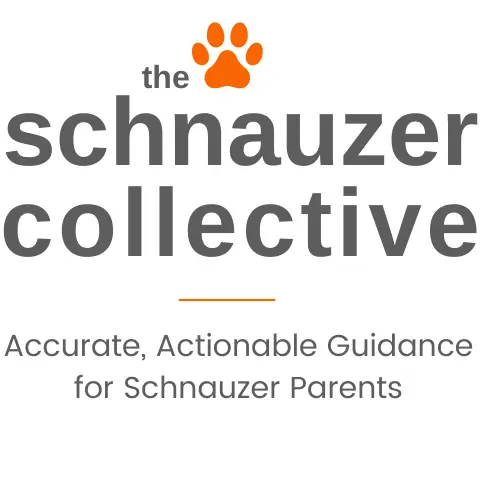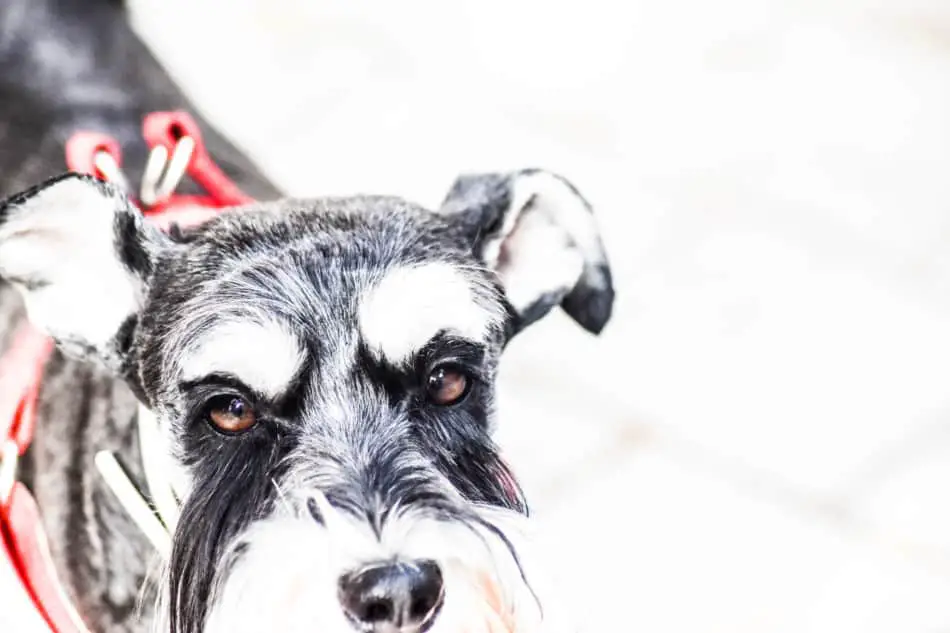Eyesight is one of our most precious senses. To have clear vision and healthy eyes is something we might take for granted until it wanes. As we worked through a few eye issues within our immediate and extended family, I began to pay more attention to our Schnauzer’s eyes as well. I wanted to make sure we knew about potential eye conditions, including common ones like cataracts. Here’s what I learned.
Do Schnauzers develop cataracts? Yes, all Schnauzer breeds are prone to cataracts. In addition, Schnauzers can develop other serious eye conditions such as Cherry Eye, Glaucoma, and Eye Ulcers. Paying close attention to a Schnauzer’s eye health can help with early detection and treatment.
Like humans, Schnauzers can suffer from congenital eye issues, infections, and problems associated with aging eyes, such as cataracts. In addition, eye health can be a sign of a related disease, such as diabetes.
Knowing common Schnauzer eye issues and staying alert to the symptoms can help to prevent serious outcomes, such as blindness.
Canine Cataracts
Cataracts are among the most common eye problems affecting Schnauzers. They can affect all breeds and ages of schnauzers. Although more common in senior schnauzers, cataracts can be triggered by inadequate nutrition, an infection, diabetes, an injury, or any other trauma.
Unfortunately, Miniature Schnauzers are more likely to develop canine cataracts compared to other Schnauzer breeds.
This condition disrupts the normal arrangement of the fibers of your Schnauzer’s eye, which can completely or partially block the clarity of her lens, causing blindness in the long run. As with humans, cataracts should be surgically removed. The good news is that early detection by a veterinarian and correct treatment can successfully restore your Schnauzer’s vision.
Cataract Symptoms
The symptoms and signs of cataracts are fairly straightforward, although tricky to specifically determine.
This is because an additional eye condition, known as nuclear sclerosis, normally occurs in dogs that are over six years of age. It does not affect your Schnauzer’s vision and no treatment is necessary, but it can look like cataracts. The lens will look paler than normal and possibly slightly white, gray, or blue. It really stems from a natural fading of eye color due to aging.
So, how should you detect cataracts?
The simple answer is to keep an eye (pun intended) on your Schnauzer’s eyes. Check them regularly and stay alert to changes. If you notice any cloudiness begin to develop, it’s time to call your veterinarian.
Cataract Risk Factors
Unfortunately, as I mentioned above, Miniature Schnauzers are one of several dog breeds that are prone to develop cataracts.

In addition to being aware of that major risk factor, here are several other risk factors you should be aware of:
- Old age
- Congenital cataracts (being born with cataracts)
- Diabetes mellitus
- Nutritional disorders
- Injury or eye trauma
- Hypocalcemia (very low calcium levels in the blood)
- Eye Inflammation
- Secondary development in combination with other eye diseases like glaucoma
- Electric shock
- Exposure to radiation or toxic substances
Cataract Treatment
Canine cataracts might be quite small, but if left untreated and the cataracts become very dense, your Schnauzer might eventually go blind. The only treatment for this condition is surgery, and thankfully, the procedure has a success rate of between 85% and 90%. Your Schnauzer will need anesthesia, but the procedure is quite similar to cataract surgery in humans.
An artificial lens is usually implanted in the eye to substitute the cataract lens. Schnauzers can see without the artificial lens, but the images will not be in focus. You will want to discuss with your veterinarian and possibly an ophthalmologist whether your Schnauzer will benefit from the artificial lens.
Once the cataracts are removed, they do not recur.
After surgery, your Schnauzer will need wear an Elizabethan collar (cone of shame) until the eye heals. You will need to keep her fairly quiet and calm, and will need to apply eye drops a few times each day for several weeks.
Symptoms of Additional Schnauzer Eye Concerns
To best manage the health of your Schnauzer’s vision, pay close attention to her eyes so that you can identify any problems early. By conducting frequent checks, you can easily identify any changes that might require the advice of a veterinarian.

Here is a list of the common signs you should watch for:
- Redness
- Cloudiness
- Swelling, puffiness or inflamed looking eyes
- Bumping into things
- Aversion to bright light
- Pawing at the face or eyes
- Reluctance to use stairs
- Reluctance to jump
- Reluctance to go to unfamiliar places
- Behavioral changes like apprehensive behavior
- Partially closed eyes or squinting
- Being confused or startling easily
10 Additional Eye Concerns to Know About
Aging Eyes
Your Schnauzer’s eyes will naturally age as she grows older. Even if your dog never had any eye problems before, as an older dog, its vision might be limited. The common age-related change that most canines develop is known as nuclear sclerosis, and most people mistake it for cataracts because the eye lens becomes cloudy. This condition causes a mist of blue-gray in the middle of the lens, but it doesn’t have any severe effects on the vision of your dog.
Cherry Eye
Generally, the third eyelid of your schnauzer rests unseen underneath the inner corner of the eye when it is healthy. However, there’s a tear gland that can pop out within this eyelid, giving your pet a cherry-like swelling in the corner of the eye.
Schnauzers are genetically susceptible to cherry eye, and most of the ligaments that hold the eyes in place may weaken, making the tear glands to pop out. This condition can only be treated through a surgical procedure to restore the tear gland to its original position.
Corneal Ulceration or Eye Ulcers
Cornea ulceration refers to lesions or defects in the outer cells of a Schnauzer’s cornea and can be very painful. This condition can be caused by various things, from simple things like an ingrown eyelash to more traumatic things like an injury or accident. Cornea ulceration causes the eyes of the dog to become swollen and red, and immediate medical care is required to prevent loss of vision. The treatment of this condition depends on the seriousness of the ulceration and might probably include a combination of eye drops and eye ointments together with antibiotics.
Pink Eye or Conjunctivitis
Pink eye is a viral or bacterial infection. This condition is irritating and painful to an affected Schnauzer. Symptoms of conjunctivitis include pronounced inflammation and redness, swollen eyelids, squinting thick discharge, or excessive tearing. If left untreated this condition can damage the cornea permanently, so you should really take your Schnauzer to a veterinarian. With a proper diagnosis, antibiotics can be used to clear up this condition.
Dry Eye
This eye problem is the result of insufficient production of tears. Tear production is usually important to keep your Schnauzer’s eyes lubricated. Without it, the eyes will be dry and very painful and eventually lead to eye ulcerations, infections, and loss of vision. Treatment for dry eye entails keeping the eyes of lubricated using prescription medications that stimulate the production of tears.
Glaucoma
Glaucoma is generally a severe condition in dogs that, if not detected and treated immediately, might lead to blindness. It’s the accumulation of fluid within the eye, which causes high pressure inside the eyes, causing permanent damage to the optic nerve and retina. The symptoms for glaucoma include dilated pupil, cloudiness of the cornea, bloodshot eyes, behavioral changes, or your schnauzer showing signs of pain. The treatment of glaucoma involves medications to help relieve pain and pressure. In some cases, surgical procedures might also be needed to manage this condition.
Epiphora
Epiphora refers to excessive tear production, which is not an independent eye condition but a sign of other underlying problems. The most common culprit of all is a blockage in the tear ducts. Symptoms of Epiphora often include dampness and wetness under the eyes, skin irritations, brown stains beneath the affected eye, and bad odor. Epiphora treatment significantly depends on the underlying causes of the condition. Once the root cause is treated, this condition should clear up quickly and easily.
Ectropion
Ectropion refers to a physical condition where the eyelid of a dog rolls outward, exposing the inner eyelids to harmful elements. The treatment for this condition involves ointments or drops to help with any eye infections that occur.
Entropion
Entropion refers to a physical condition where the eyelid of a dog rolls inwards. It can occur due to either lower or upper eyelids. This condition causes the hairs on the eyelids to brush against the cornea leading to spasms and irritation. Entropion is very painful and can only be improved through surgical treatment.
Progressive Retina Atrophy (PRA)
Among the eye problems most dog breeds can have, progressive retinal atrophy is usually the hardest to identify. In most cases, the eyes of your Schnauzer might look very healthy, when in reality she is gradually losing her vision.
As a result, the most common sign that a dog might have this condition is increasing difficulty seeing in the dark. Progressive retinal atrophy is painless, but it sadly has no cure. Nonetheless, because vision loss occurs gradually, your canine will easily adapt to the situation.
Taking good care of your Schnauzer’s eyes begins with simply looking at them often. Noticing changes early will ensure that you can get the intervention and treatment she needs.
And finally, from one pet parent to another, discover my all-time favorite resources designed to cover your every Schnauzer need. I’ve done the legwork for you so you can spend more time with the people and fur friends in your life.
A portion of all profit earned on this site is donated to Pet Partners
whose mission is to improve human health and
well-being through the human-animal bond.
They train and register pets to become therapy animals,
and have local chapters in many states.

